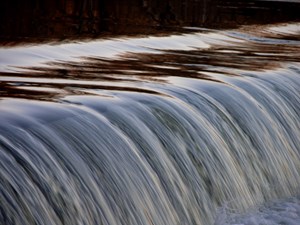Extended reprieve for New Orleans water systems as saltwater intrusion slows
NEW ORLEANS (AP) — Authorities said that saltwater inching up the Mississippi River is progressing more slowly than projected, meaning water systems in the greater New Orleans area that draw drinking water from the river have additional weeks to prepare.
For some small systems downriver, the projected arrival of salt water was pushed back to later this month. For New Orleans and neighboring Jefferson Parish, the threat to water system intakes was pushed back from late October to late November. And intakes for large portions of the city and Jefferson Parish now are not expected to see salinity above 250 parts per million, a level that triggers health warnings.
Unexpected October or November rains could further delay and diminish the threat, said Col. Cullen Jones, commander of the U.S. Army Corps of Engineers' New Orleans District.
Typically, the Mississippi's flow is sufficient to prevent salt water from moving far upstream. But for the second year in a row, hot and dry weather has lowered the river, allowing a denser, heavier layer of salt water from the Gulf to push inland.
State, local and federal officials discussed the latest projections at a news conference at the Corps' New Orleans headquarters. Jones cited two factors in the latest projections: an underwater sill downriver has succeeded in impeding the heavy salt water's flow upriver; and weather and river forecasts, while still showing a continued drop in the river's usual downriver flow, are more optimistic.
Salt water that overtops the underwater sill is still lower in salinity than the water behind the sill toward the Gulf, Jones said.
"This updated projection is clearly a relief to all of us," said Collin Arnold, New Orleans' emergency director.
Salt water already has reached some Plaquemines Parish communities closer to the river's mouth — Boothville, Port Sulphur and Pointe a la Hache. But communities such as Belle Chasse, Dalcourt and St. Bernard have gained another week or two to prepare. In the immediate New Orleans metro area, people who had been told their systems would be threatened by late October saw projections pushed back to Nov. 23 and beyond.
Officials said multiple efforts to provide safe water to the downriver systems continue, including barging large amounts of fresh water to the intakes and installing better filtration systems. For the heavily populated parts of New Orleans and neighboring Jefferson Parish, where barging water is not practical, plans continue for pipelines to shunt fresh water from farther upriver.
For New Orleans alone, the pipe system costs have been projected at $150 million to $250 million. Local and state authorities expect much of the cost to be covered by the federal government. President Joe Biden said late last month that federal disaster assistance would be made available to Louisiana.
Jones stressed that even the updated projections are worst-case scenarios. The threat could be further delayed and diminished if rain is added to the forecast for October and November.
State health officer Dr. Joseph Kanter used a familiar Gulf Coast analogy, likening the changed projection to a tropical storm altering its course in the Gulf.
In addition to being unsafe to consume, salt water poses another health threat in that it can corrode pipes. It's especially a problem in older systems, like the one in New Orleans, that still have lead pipes in some areas.
According to the Sewerage & Water Board of New Orleans, the majority of water mains in the city center were installed prior to 1940. According to the Environmental Protection Agency, homes built before 1986 are more likely to have lead pipes. Many homes built before the 1986 Safe Drinking Water Act have either lead pipes or lead solder in the plumbing systems.
Exacerbating problems posed by a diminished river flow is sea level rise.
The sea level around New Orleans is rising at a rate of as much as 9 millimeters per year, or three feet (91 centimeters) each century, much higher than the global average and the highest rate measured in the United States, according to experts at NOAA's Center for Operational Oceanographic Products and Services. That is because the Gulf Coast region is a "hotspot" of subsidence, the experts said, meaning land is sinking even as the sea level rises.
Related News
From Archive

- Glenfarne Alaska LNG targets late-2026 construction start for 807-mile pipeline project
- U.S. water reuse boom to fuel $47 billion in infrastructure spending through 2035
- $2.3 billion approved to construct 236-mile Texas-to-Gulf gas pipeline
- Major water pipe break in Puerto Rico hits over 165,000 customers
- Potomac River Tunnel project enters construction phase beneath Washington, D.C.
- Pennsylvania American Water launches interactive map to identify, replace lead water service lines
- Trump's tariffs drive $33 million cost increase for Cincinnati sewer project
- Utah city launches historic $70 million tunnel project using box jacking under active rail line
- Tulsa residents warned after sewer lines damaged by boring work
- Fatal trench collapse halts sewer construction in Massachusetts; two workers hospitalized




Comments